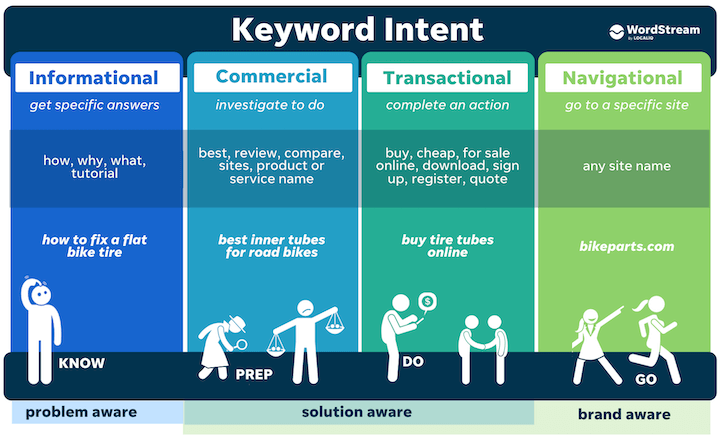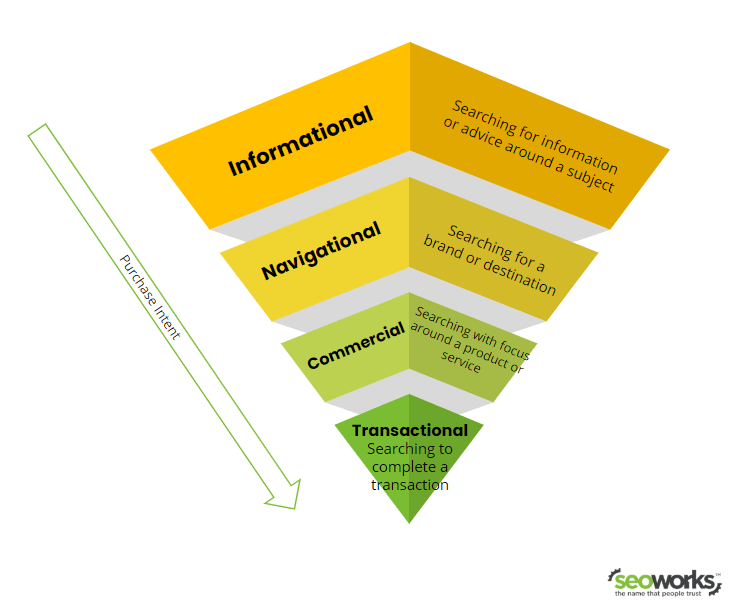Unlock the power of search intent in SEO and skyrocket your website traffic with this essential guide. Don’t miss out!

Image courtesy of via DALL-E 3
Table of Contents
Welcome to the world of Search Intent and its significance in the realm of Search Engine Optimization (SEO). In simple terms, Search Intent is all about understanding why people search for things online and how it impacts the results they get. Imagine you’re searching for a recipe for chocolate chip cookies. The reason you’re looking for it (to bake yummy cookies) is your search intent! Let’s dive into what Search Intent is and why it matters, using examples that’ll make it crystal clear.
What Is Search Intent?
Search Intent is the reason behind why someone searches for something on the internet. It can be to find information, navigate to a specific website, or make a purchase. For instance, if you look up “how to tie a tie,” your intent is to learn how to tie a fancy knot. So, Search Intent is like a secret code that tells search engines what you’re really looking for!
Why Is Search Intent Important?
Understanding Search Intent is crucial in SEO because it helps search engines like Google show you the most helpful results. When search engines know your intention, they can match it with the most relevant websites. This means you get what you need quicker and websites get more visitors who are genuinely interested. So, knowing Search Intent is like having a magic wand that helps you find what you’re seeking on the internet effortlessly!
Types of Search Intent
When we talk about search intent, we can break it down into different types depending on what people are looking for. Let’s explore the three main types of search intent: informational, navigational, and transactional.
Informational Search Intent
Informational search intent is when someone is looking for information or answers to a question. For example, if you type “How do plants grow?” into a search engine, you have informational search intent because you want to learn about plants. Other examples include searching for news updates, recipes, or historical facts.
Navigational Search Intent
Navigational search intent is when someone is trying to find a specific website or page. If you type in the name of a website like “YouTube” into a search engine, you have navigational search intent because you want to go directly to that website. People also use navigational search intent to find their favorite social media platforms or online stores.
Transactional Search Intent
Transactional search intent is when someone is ready to make a purchase or take a specific action. For example, if you search for “buy red sneakers” online, you have transactional search intent because you are looking to purchase red sneakers. This type of search intent is common for e-commerce sites or service providers.
How to Identify Search Intent
Understanding search intent is crucial in creating content that matches what users are looking for. Here’s how you can identify search intent:
Looking at Keywords
One way to identify search intent is by looking at the keywords people use in their search queries. For example, if someone searches for “best chocolate cake recipe,” their intent is likely informational as they are seeking information on how to make a chocolate cake. On the other hand, if someone searches for “buy chocolate cake online,” their intent is transactional, indicating they are ready to make a purchase.
Using Tools
Online tools like Google Analytics and Google Search Console can also help you understand search intent. These tools provide insights into the search terms people use to find your website and the actions they take once they land on your page. By analyzing this data, you can better tailor your content to match the intent behind these searches.
Search Intent and Content Creation
When it comes to creating content for a website, it’s essential to make sure that the content matches what people are searching for. This means understanding the intent behind their search. For example, if someone is looking for information on how to bake a cake, they wouldn’t want to see content about fixing a car. By aligning your content with the search intent, you are more likely to attract the right audience to your website.

Image courtesy of www.wordstream.com via Google Images
Writing for Different Intents
Depending on the type of search intent, the content you create should vary. For informational search intent, your content should focus on providing valuable and educational information. If the search intent is navigational, your content should make it easy for users to navigate and find what they are looking for. And for transactional search intent, your content should be geared towards converting visitors into customers by providing clear calls to action.
Improving SEO with Search Intent
Understanding search intent and aligning your content with it can significantly improve your website’s rankings on search engines. When your content matches what users are looking for, search engines like Google are more likely to rank your pages higher in search results. For example, if someone is searching for “best hiking trails,” and your website provides detailed guides and maps of popular hiking trails, Google will recognize the relevance of your content to the user’s search query.
More Traffic
By grasping search intent, you can attract more visitors to your website. When your content meets the specific needs and interests of your target audience, people are more likely to click on your website in search results. This not only increases traffic but also enhances the overall user experience. For instance, if a user is searching for “easy dinner recipes,” and your website offers quick, delicious recipes with step-by-step instructions, users are more inclined to visit your site for meal ideas.
Real-life Examples
Let’s imagine Sally, a passionate young writer who decides to start a blog about her favorite topic, space exploration. Sally knows that in order to attract readers, she needs to understand what they are searching for. By researching popular keywords related to space exploration and analyzing the search intent behind them, she tailors her blog posts to match what her audience wants to know. As a result, Sally’s blog quickly gains traction, with more and more visitors finding her site because she has aligned her content with the search intent of her audience.

Image courtesy of www.seoworks.co.uk via Google Images
Example of a YouTube Channel
Now, let’s meet Alex, a teenager who loves playing video games. Alex decides to start a YouTube channel where he uploads gameplay videos and reviews of different games. To grow his channel, Alex studies what types of videos gamers are searching for online. By identifying the search intent behind popular gaming-related keywords, Alex creates content that directly addresses the needs and interests of his audience. As a result, his channel gains subscribers and views, showing how understanding search intent can help a YouTube channel thrive.
Common Mistakes to Avoid
One of the most common mistakes people make when it comes to search intent is guessing the wrong intent behind a search query. For example, if someone is searching for “best restaurants in town,” assuming they are looking for recipes instead of actual dining locations would lead to irrelevant content. To avoid this mistake, it’s crucial to thoroughly analyze the keywords and context of the search query before creating content.
Ignoring Search Intent
Another pitfall to avoid is completely disregarding search intent in your SEO strategy. Focusing solely on keywords without considering the underlying purpose of a user’s search can lead to a disconnect between your content and what users are actually looking for. By ignoring search intent, you risk creating content that fails to resonate with your target audience, ultimately hindering your SEO efforts.
Want to turn these SEO insights into real results? Seorocket is an all-in-one AI SEO solution that uses the power of AI to analyze your competition and craft high-ranking content.
Seorocket offers a suite of powerful tools, including a Keyword Researcher to find the most profitable keywords, an AI Writer to generate unique and Google-friendly content, and an Automatic Publisher to schedule and publish your content directly to your website. Plus, you’ll get real-time performance tracking so you can see exactly what’s working and make adjustments as needed.
Stop just reading about SEO – take action with Seorocket and skyrocket your search rankings today. Sign up for a free trial and see the difference Seorocket can make for your website!
FAQs on Search Intent
What if I Don’t Know the Search Intent?
If you are unsure about the search intent behind a query, don’t worry! You can try to analyze the keywords used in the search to get a better idea of what the user might be looking for. Additionally, you can look at the search results to see what type of content is ranking high, which can give you clues about the search intent.
How Often Should I Check Search Intent?
It’s a good idea to periodically revisit and reassess search intent for your target keywords. As trends and user behavior evolve, search intent may also change. By staying up-to-date with search intent, you can ensure that your content remains relevant and continues to meet the needs of your audience.
Does Search Intent Change?
Yes, search intent can change over time. As new trends emerge, user behaviors shift, and search algorithms evolve, the intent behind certain searches may also undergo changes. To adapt to these shifts, it’s important to regularly monitor and analyze search intent data to better align your content with what users are looking for.







